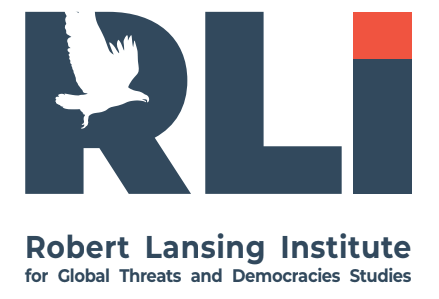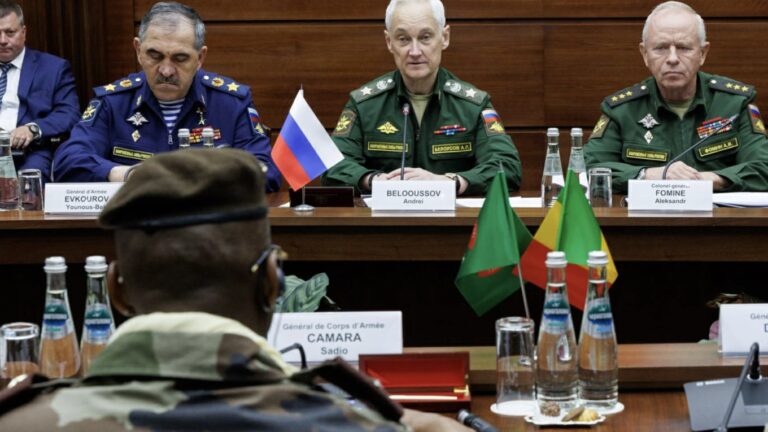Between Burkina Faso, Mali, and Niger, the Alliance of Sahel States (AES)—also known as the Confederation of Sahel States—was officially established in July 2024 as a mutual defense and political. After withdrawing from the Economic Community of West African States (ECOWAS) in early 2025, these juntas have realigned diplomatically, distancing themselves from Western and ECOWAS influence.
In April 2025, foreign ministers of the three countries visited Moscow to discuss military cooperation, including training and the creation of a joint armed.
Now, in August 2025, the defence ministers of these three AES states held their first official military consultationswith their Russian counterpart, Andrei Belousov—marking an elevated level of engagement .
1. Aims of the Visit
Official Objectives
- Conduct first-ever consultations between the defence chiefs of Russia and the AES members.
- Sign a memorandum of understanding (MoU) on defense cooperation.
- Express Russia’s readiness to provide comprehensive assistance aimed at ensuring regional stability.
Underlying Strategic Goals
- Formalizing a security partnership: The visit strengthens military institutional ties—and supports the development of a planned 5,000-strong joint Sahel force against jihadist threats.
- Filling the post-Western void: With Western powers gone, Russia is positioning itself as the new security and geopolitical partner to these three juntas .
- Securing long-term cooperation: Through MoUs and shared military frameworks, Russia is entrenching its presence via both diplomatic and paramilitary channels (e.g., expansion of the Africa Corps)
2. Why Now?
- First anniversary of AES: July 2025 marked one year since the creation of the Alliance, offering symbolic timing for formalizing military negotiations .
- Escalating security crisis: The Sahel continues to face deepening jihadist insurgencies and instability—which the AES strives to contain collectively.
- Geopolitical shifts: As ECOWAS and Western involvement receded, Russia saw an opportunity to advance in an under-contested security market.
- Momentum from April diplomatic gains: The foreign minister-level visit earlier set the political groundwork; now the defence-level summit elevates commitment to tangible military cooperation.
3. Potential Consequences
Positive Outcomes
- Operational coordination: AES’s joint military structure gains legitimacy and technical support—key for coordinated counter-insurgency operations.
- Expanded Russian influence: Russia positions itself as a key security partner, securing a foothold in a strategic resource-rich region.
- Entrenchment of paramilitary presence: The Africa Corps—a Russian government-controlled force—deepens its operational footprint in AES countries .
Risks and Limitations
- Diplomatic dependence: Over-reliance on Russia may undermine regional political autonomy and render AES vulnerable to external demands.
- Regional isolation: This orientation further isolates AES from regional blocs like ECOWAS and could destabilize broader West African cooperation.
- Credibility concerns: AES junta states face legitimacy questions, and close military ties with Moscow may trigger international sanctions or pushback.
- Resource-backed influence: Military support could be exchanged for access to strategic resources—fueling resource neocolonialism dynamics.
Russia’s recent behavior in Africa shows a consistent “security-for-resources” model, and the Sahel is particularly suited to this approach:
1. Precedent in Mali and CAR
- In Mali, after the Wagner Group’s arrival (now rebranded as the Africa Corps), Russian-linked companies gained mining concessions in gold-rich sites such as the Fekola and Loulo regions.
- In the Central African Republic, Russian military assistance was followed by exclusive rights for companies like Lobaye Invest to extract gold and diamonds.
- These arrangements are often opaque, bypassing standard tender processes, and usually benefit entities tied to Russian intelligence or the Ministry of Defence (so called former GRU).
2. Strategic Sahel Minerals
- Niger is the world’s 7th largest producer of uranium—supplying both civilian nuclear markets and potentially sensitive stockpiles.
- Mali and Burkina Faso hold significant gold reserves and artisanal mining zones that are easy for a foreign security partner to secure.
- Control over these sectors also means leverage over informal smuggling routes, which can be monetized in ways invisible to international monitoring.
3. Mechanism of Access
- Military agreements with AES states can include “confidential” annexes on economic cooperation.
- Deployment of Russian Africa Corps units to protect mines, transport corridors, and export terminals gives Moscow de facto control over resource flows.
- Payments for military training, equipment, and operations are often offset via mining concessions or rights to future resource revenues — a barter model that avoids the need for hard currency transfers, useful under sanctions.
4. Why Uranium Is Especially Attractive Now
- Since Rosatom faces increasing Western scrutiny, alternative uranium sources like Niger can help secure fuel for Russia’s civilian and military nuclear sectors.
- Uranium deals can also be used as political leverage with third countries — for example, reselling enriched fuel to partners in the Middle East or Asia.
5. Risks for Sahel States
- Loss of sovereignty over key national assets.
- Entanglement in opaque, long-term deals that outlive current regimes.
- Environmental degradation and social unrest in mining areas, which could fuel further insurgencies.
- Possible sanctions from the EU or U.S. targeting specific mining entities or state agencies.
Mning zones in the AES (Mali, Burkina Faso, Niger) are already flashpoints, and current policies (tight state control + security-for-resources deals) raise the odds of protests → repression → insurgent recruitment over the next 6–12 months.
What’s driving unrest
1) Jobs & income shocks
- Niger’s uranium belt (Arlit–Akokan) has seen shutdowns and near-bankruptcy at SOMAIR, throwing local economies into crisis—classic protest fuel, with further anger over nationalisation vs. foreign control narratives 2) Safety failures in artisanal gold
- Mali suspended new foreign artisanal permits after fatal accidents; when authorities restrict artisanal pits without alternatives, informal miners (and their families) often protest or drift toward armed groups who “tax” and protect sites
3) Jihadist penetration of the gold economy
- In Burkina Faso/Mali/Niger, jihadist groups (JNIM/ISGS) systematically extract taxes from pits, traders, and convoys; attacks on mine convoys both terrify communities and signal insurgent control when the state can’t protect roads. 4) Heavy-handed state resets with miners
- Across the “coup belt,” governments are rewriting mining rules, seizing product, detaining executives, and forcing ownership changes. Locals often read this as elite rent-shifting, not community benefit—raising grievance if services/jobs don’t improve quickly.
5) Local environmental/land grievances
- Long-standing complaints (mercury/cyanide use, water drawdowns, land access, unfair compensation) combine with today’s militarised site security to harden community-state antagonism—fertile ground for mobilisation. (See broad Sahel mining–conflict evidence.)
Hotspots & 6–12 month outlook
Niger – Arlit/Akokan (uranium)
- Triggers: prolonged SOMAIR suspension; layoffs/wage arrears; disputes over stockpiles; tighter movement around sites; “replacement” partners arriving.
- Risks: street protests escalating into clashes; sabotage of power/water lines; jihadist propaganda exploiting anti-French then anti-“new patron” sentiment.
- Outlook: High unrest risk; medium insurgent spillover (ISGS presence north/east).
Burkina Faso – Essakane/Houndé/Boungou corridors (gold)
- Triggers: convoy ambushes; tighter curfews and requisitions; new tax/ownership rules hitting artisanal miners.
- Risks: communities block roads to mines; retaliatory sweeps by security forces; further high-casualty convoy attacks feeding grievance and displacement.
- Outlook: Very high security volatility; high risk of unrest synergising with insurgent control of trade routes.
Mali – Kayes/Sikasso/transition zones (gold)
- Triggers: closures of unsafe pits; enforcement of new codes; disputes with industrial operators (tax/ownership); fatalities at artisanal sites.
- Risks: mine-site protests, strikes, local leaders targeted as “collaborators”; insurgent “protection” rackets expand.
- Outlook: High unrest potential, especially where artisanal miners are displaced without livelihood plans.
How Russian security ties could amplify unrest
- Militarised site protection (Africa Corps or local auxiliaries) often means checkpoints, interdictions, and forced clearances around pits—flashpoints with artisanal miners and transporters. Insurgents capitalise by offering “access” and justice forums. (Pattern seen in prior Sahel mining conflicts.)
- Security-for-resources optics: if communities don’t see clinics, water, or jobs, but do see guarded ore trucks and foreign advisers, grievance narratives (“they take the gold/uranium, we get funerals and dust”) spread fast.
- Revenue opacity: barter concessions for security services are hard to audit; when prices spike (e.g., uranium), suspicions of elite capture grow.
Early-warning indicators to watch
- Company notices of production halts, workforce reductions, or “care-and-maintenance” (esp. Arlit/SOMAIR; any Essakane throughput cuts).
- Permit crackdowns on artisanal zones without parallel livelihood plans (Mali Interior/Security communiqués)
- Road security: frequency of IEDs/ambushes on mine corridors (Boungou–Fada N’Gourma; Essakane axes).
- Local protest cues: unions/collectives in Arlit, Kayes, Houndé calling marches or strike funds; radio/FB pages announcing blockades. (Triangulate with NGO alerts.)
- Rule changes & seizures: abrupt royalty hikes, state product seizures, or detentions of executives—usually followed by labour/community agitation.
Mitigation options
- Community benefit compacts tied to tonnage: transparent funds for water/health/education paid per kg/ton, published monthly. (Reduces “theft” narratives.)
- Safe-artisanal corridors: formalise artisanal zones with safety training, mercury reduction, and licencing—cheaper than mass evictions and undercuts jihadist “taxation”.
- Mine-route protection with civilian oversight: embed complaint hotlines, compensation protocols for search/seizure abuses, and independent monitors on convoys.
- Crisis employment buffers at uranium sites: wage guarantees or public-works stints during shutdowns to head off protests and recruiter appeal.
Russia can protect only some mineral-resource sites in the Sahel, but not all — and not in a way that guarantees stability without side effects.
Here’s a breakdown of capacity, constraints, and likely outcomes:
1. What Russia Can Do
- Rapid Deployment of Africa Corps Units
Russia has already deployed paramilitary personnel (successor to Wagner) to Mali, Burkina Faso, and CAR to guard mining sites, secure roads, and train local forces.
In Mali’s gold zones, such units have successfully set up “secure bubbles” around industrial mines, deterring small insurgent raids. - Force Multiplication via Local Auxiliaries
They can integrate AES state troops and gendarmes into mixed patrols, providing command-and-control, surveillance, and tactical training. - Infrastructure Hardening
Russian teams have experience fortifying sites—perimeter fencing, surveillance drones, convoy escort SOPs—learned in Syria, Libya, and CAR.
2. Where the Limits Show
- Geography & Dispersion
Gold and uranium zones in Mali, Burkina Faso, and Niger are spread over hundreds of kilometers, often in jihadist-contested terrain. Russia doesn’t have the manpower to secure all of them simultaneously. - Insurgency Scale
Groups like JNIM and ISGS can mass hundreds of fighters for attacks, hit roads with IEDs, and withdraw quickly. Protecting the mine site is easier than keeping supply and export routes safe. - Logistics & Sustainment
Supplying Africa Corps detachments in remote areas depends on local government cooperation, functioning airstrips, and convoy routes—all vulnerable to ambush or sabotage. - Political Risk
Heavy Russian presence can inflame local grievances (seen in CAR), which insurgents exploit for recruitment—turning “protection” into a cause for further unrest. - Multiple Commitments
Russia is already stretched with Ukraine, Syria, Libya, and other African engagements (Sudan, CAR). The Sahel is not its top strategic theatre, meaning resources are finite.
3. Most Likely Protection Model
- Prioritization of High-Value Sites
Russia will focus on:- Niger’s uranium belt (Arlit, Akokan) — strategic for Rosatom.
- Industrial gold mines with existing or negotiated concessions for Russian-linked firms.
- Selective Corridor Control
Securing main export roads (e.g., Essakane–Ouagadougou, Loulo–Bamako) rather than dispersed artisanal zones. - Intelligence-Driven Deployment
Using HUMINT and drones to respond to threats, not maintain 24/7 area coverage.
4. What This Means for AES States
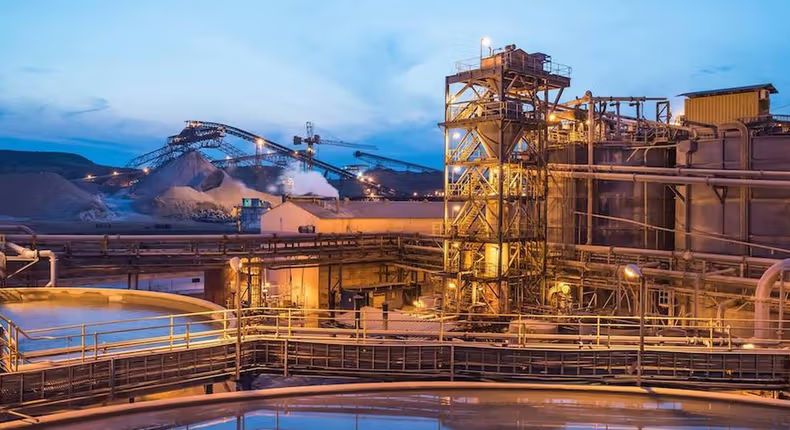
More on this story: Africa’s New Overseers: Inside Russia’s Covert Gold Empire”
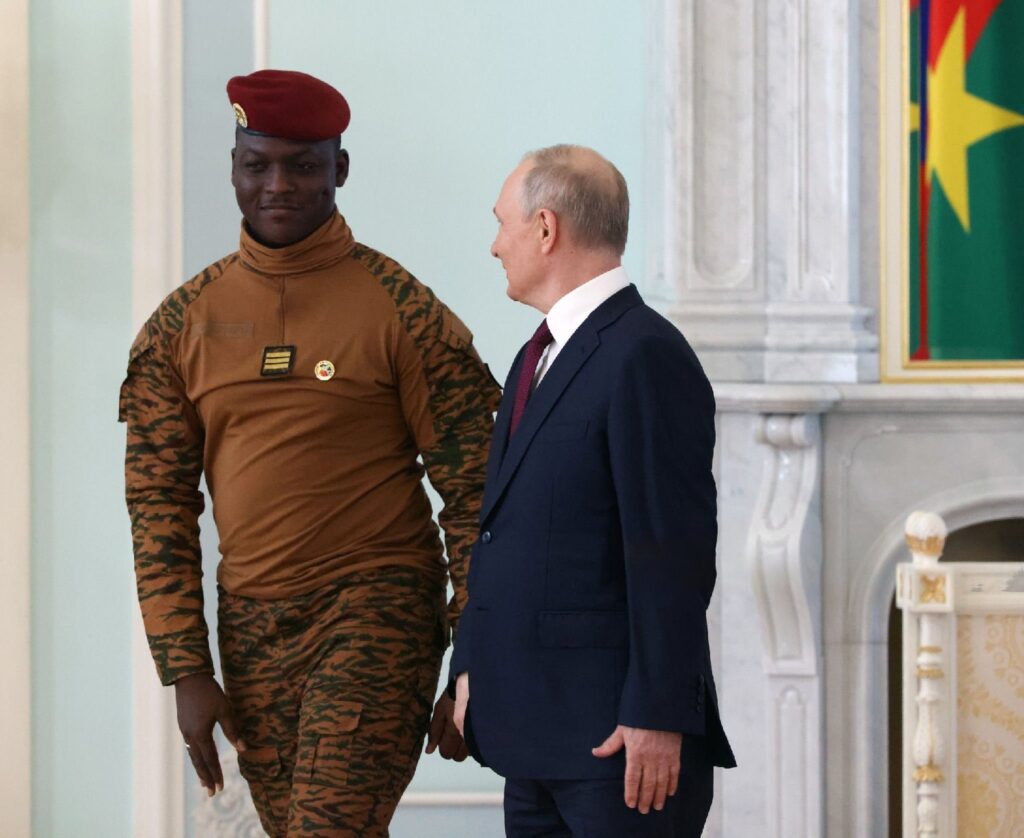
More on this story: From Liberation to Exploitation: Russia’s Resource Deals in Africa
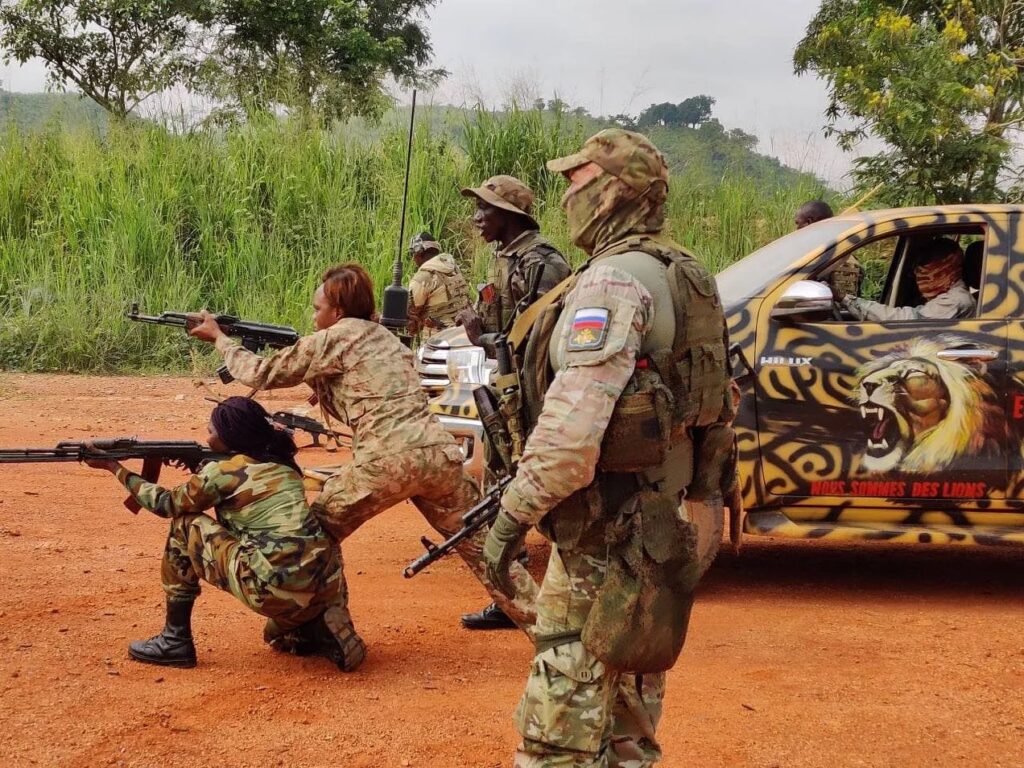
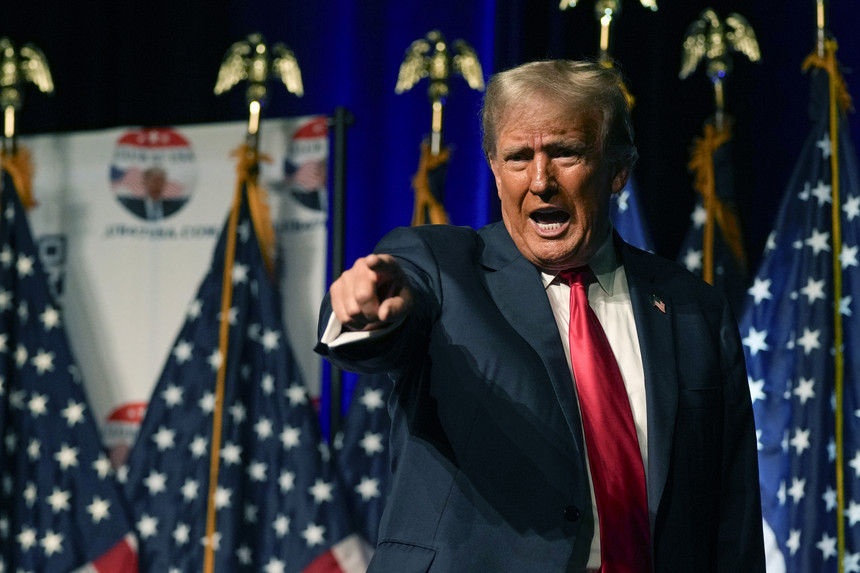
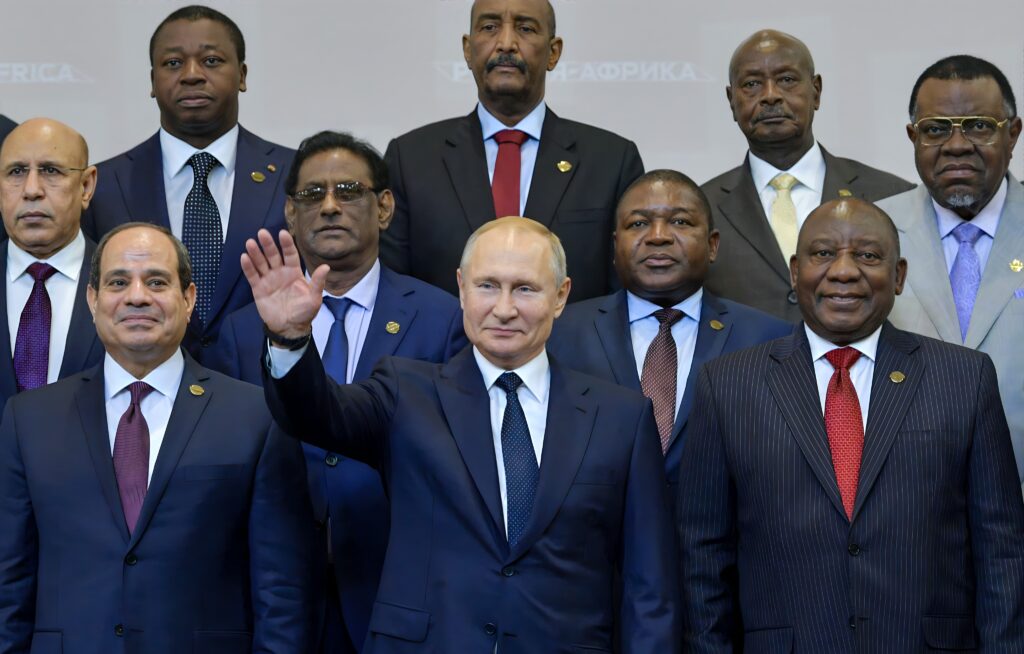

More on this story: Gold mines in Burkina Faso fuel militant and jihadist groups
- Strategic sites may be safer, but artisanal zones, small operators, and secondary roads will remain exposed to insurgent taxation and attacks.
- Resource protection will come with strings—likely long-term concessions, opaque revenue deals, and increasing Russian influence over economic policy.
- Security may be more about regime survival than community stability, with Russian protection focusing on mines tied to political patrons.
